.
Der Koloss von Rhodos
And so you shall; ascend, therefore, in imagination with me to the Moon, and consider the situation and appearance of the earth from thence: suppose it to seem, as it did to me, much less than the moon, insomuch, that when I first looked down, I could not find the high mountains, and the great sea; and, if it had not been for the Rhodian Colossus, and the tower of Pharos, should not have known where the earth stood.
Lucian of Samosata
Astronauts are supposed to be able to see the Great Wall in China. Also the first Greek Astronaut Mennipus on his trip to the moon tried to see if the Colossus of Rhodes is visible.
To you, O Sun, the people of Dorian Rhodes set up this bronze statue reaching to Olympus when they had pacified the waves of war and crowned their city with the spoils taken from the enemy. Not only over the seas but also on land did they kindle the lovely torch of freedom.
Dedicatory inscription of the Colossus of Rhodes
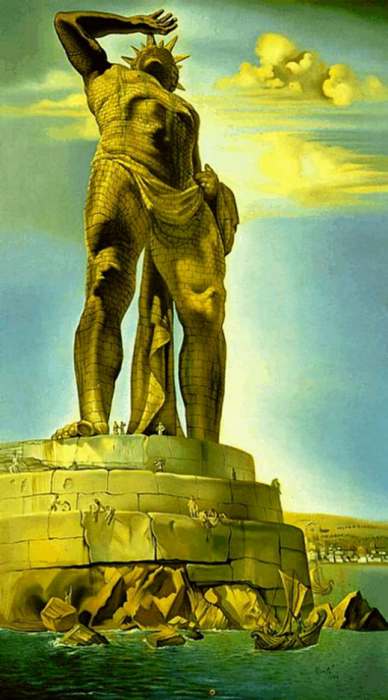
The Colossus of Rhodes ( Salvador Dali )
Technology in the Greek island of Rhodes was advanced around the period of Alexander the Great. The island was known for its technology of war machines. Some assume that it produced machines like the Antikythera device. One example of construction technology from Rhodes was the Colossus of Rhodes, a gigantic statue. Lysippus a sculptor constructed already a 15 m high statue of Zeus. The Colossus of Rhodes was approximately as large as the Statue of Liberty in New York. It is one of the 7 Wonders of the Ancient World described by the poet Antipater of Sidon around 130 BC.

The Colossus of Rhodes. The image of this stamp shows an impossible reconstruction for the material used. The statue was rather more similar to the Statue of Liberty in New York. , Stamps of the Seven Wonders of the World
After the death of Alexander the Great fights broke out between his generals. During the fighting Rhodes had sided with Ptolemy I Soter*, and when Ptolemy eventually took control of Egypt, they formed an alliance which controlled much of the trade in the eastern Mediterranean. Another of Alexander's generals, Antigonus, was upset by this turn of events. In 305-306 BC Demetrius son of Antigonus a general of Alexander the Great invade Rhodes with an army of 40000 (on 200 warships and 172 transport ships). Rhodes had c. 7000 men without the slaves. Demetrius was skilled in directing catapults and battering rams to crush city walls, and upon landing on the island he immediately began his efforts to break down its fortifications and defenses. Demetrius's tortoise-like armored battering rams were 180 feet long and manned by one thousand men, and his giant catapults threw 180-pound stone balls a quarter of a mile. Probably his most fearsome device was an enormous wheeled fortified tower called Helepolis (the "Taker of Cities"). This tower was 50 feet square at its base, more than 100 feet tall, and was armed with its own banks of catapults and sling throwers.
...Poliorcetes, prepared to wage war against the Rhodians, and brought in his train Epimachus, a celebrated architect of Athens. This person prepared an helepolis of prodigious expense and of ingenious and laborious construction, whose height was one hundred and twenty-five feet, and its width sixty feet: he secured it, moreover, with hair-cloths and raw hides, so that it might securely withstand the shock of a stone of three hundred and sixty pounds weight, thrown from a balista. The whole machine weighted three hundred and sixty thousand pounds.
Marcus Vitruvius Pollio, de Architectura
At the siege of Rhodes Demetrius employed an Helepolis of still greater dimensions and more complicated construction. Besides wheels it had casters antistrepta, so as to admit of being moved laterally as well as directly. Its form was pyramidal. The three sides which were exposed to attack, were rendered fire-proof by being covered with iron plates. In front each story had port-holes, which were adapted to the several kinds of missiles, and were furnished with shutters that could be opened or closed at pleasure, and were made of skins stuffed with wool. Each story had two broad flights of steps, the one for ascending, the other for descending (Diod. xx.91; cf. Vitruv. x.22). This helepolis was constructed by Epimachus the Athenian; and a much esteemed description of it was written by Dioeclides of Abdera (Athen. v. p206d). It was no doubt the greatest and most remarkable engine of the kind that was ever erected. The outlook for the island was grim.
However the city was well defended, and Demetrius had to start construction of a number of massive siege towers in order to gain access to the walls. The first was mounted on six ships, which blew over in a storm before they could be used. He tried again with an even larger land-based tower, but the Rhodian defenders stopped this by flooding the land in front of the walls so the tower could not move. In 304 BC Ptolemy sent a force of ships to help the Rhodians and the army of Demetrius left in a hurry, leaving most of their military equipment.
At Rhodes was set up a Colossus of seventy cubits high, representing the Sun...the artist expended as much bronze on it as seemed likely to create a dearth in the mines, for the casting of the statue was an operation in which the bronze industry of the whole world was concerned. Philo of Byzantium
To celebrate their victory the Rhodians decided to build a giant statue of their patron sun god Helios. The construction was left to the direction of Chares ( Χάρης ) a student of Lysippus. The Statue was built in 12 years, the construction was completed in 282 BC. It was said to have caused a shortage of bronze throughout the ancient world during its construction although Philon of Byzantium says that 13.6 tons of bronze and 8.2 tons of iron were used. For the Statue of Liberty for comparison 31 tons cooper and 125 tons iron were used (these numbers suggest that the Colossus of Rhodes required much more iron in the seismic region of Greece). Ancient accounts describe the structure as being built around several stone columns on the interior of the structure, sitting on a 15 m high white marble pedestal near the harbour entrance. Iron beams were driven into the stone towers, and bronze plates attached to the bars formed the skinning. Much of the material was melted down from the weapons Demetrius's army left behind, and the second tower was used for scaffolding around the lower levels. Upper portions were built with the use of a large earthen ramp. The height of the statue was around 32 m.
"Chares’ innovative support for the Colossus, which Philon of Byzantium described, used a system of iron struts to reinforce the structure. Chares constructed the Colossus by casting individual sections of the body, then bolting the pieces together and reinforcing them with iron struts. The statue stood on a marble platform, and Chares built it upwards from the platform starting with the feet. In order to continue working as the height of the statue increased, Chares built up a pile of dirt to work on top of. To maintain stability, he added more weight in the lower portions of the statue. Diagonal iron beams placed throughout the structure aided in its strength and durability." Steffi Julia Cerato,The Artistic Accomplishment of the Hellenistic Era
In 226 (or 224?) Rhodes was hit by an earthquake and the Colossus was destroyed only 56 years after its construction. The statue broke at the knees, the weakest point of the construction, and fell over onto the land. Ptolemy III offered to pay for the reconstruction of the statue, but the Rhodians declined to rebuild it after an oracle suggested that this would upset the god Helios. The remains laid on the ground for over 800 years, and even broken they were so impressive that many traveled to see them.
The greatest marvel of all, however, was the colossal figure of the Sun at Rhodes, made by Chares of Lindos, a pupil of Lysippos mentioned above. This figure was 70 cubits in height, and after standing 56 years was overthrown by an earthquake; but even as it lies prostrate it is a marvel. Few men can embrace its thumb : its fingers are larger than most statues, there are huge yawning caverns where the limbs have been broken, and within them may be seen great masses of rock, by whose weight the artist gave it a firm footing when he erected it. The story runs that twelve years were occupied in its construction, for which the artist received 1300 talents, produced by the sale of Demetrios' siege- train, which the king abandoned when he raised the siege of Rhodes through disgust at its protraction. Pliny the Elder
In 654 AD Rhodes was invaded by the Arabs under Muawiyah, who sold the remains of the statue. The purchaser, a Jew from Syria, had the statue broken down, and transported it on the backs of 900 camels back to his home. Pieces continued to turn up for sale for years, after being found on the caravan route.
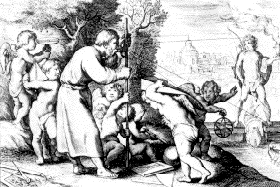
Putti measuring the Colossus of Rhodes. Peter Paul Rubens designed the engravings for the illustrations of Aguilon's major work, Opticorum libri sex philosophis juxta ac mathematicis utiles (Anvers, 1613), "Six Books of Optics, useful for philosophers and mathematicians alike", concerns geometrical optics, which in the Jesuit schools was taught under the heading of Geometry.
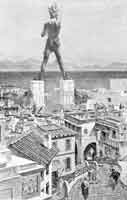
The Colossus of Rhodes, Book of Knowledge, The Grolier Society, 1911
The Colossus of Rhodes inspired the French sculptor Auguste Bartholdi, the artist of the Statue of Liberty in New York, who less known is called a modern Colossus.
Recently Wolfram Hoepfner published his research results about the Colossus of Rhodes in the following German book:
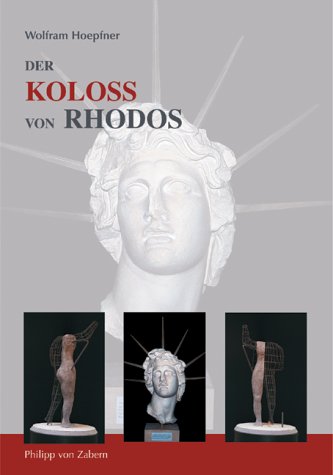
Wolfram Hoepfner, Der Koloss von Rhodos und die Bauten des Helios. Neue Forschungen zu einem der Sieben Weltwunder. Sonderband der Antiken Welt, Zaberns Bildbände zur Archälogie. Mainz am Rhein: Philipp von Zabern, 2003. Pp. 107, 72 col.
Various sculptures and reliefs of the god of sun Helios have some similarities with Alexander the Great produced after his death. It is therefore probably that also the head of the Colossus looked like Alexander.
From a discussion this is a reconstruction drawn by Hoepfner which is not very different from Salvador Dali's artistic model!
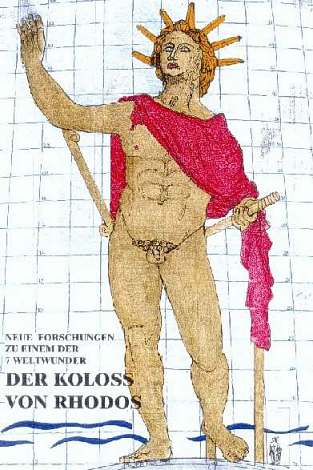
Here a part from discussions about this publication (See http://omega.cohums.ohio-state.edu/mailing_lists/BMCR-L/2004/0026.php ):
It is generally taken for granted that the Rhodian Helios was shown naked or with a short chlamys around his shoulders. Yet Greek monuments, whether sculptural or pictorial, depict him wearing the more extensive tunic of the charioteer. This costume appears not only on Rhodian amphora stamps (fig. 45) where the god rides his chariot, but also on a coffer from Priene, where Helios is on foot. None of the ancient sources on the Colossus describes his appearance; only one states that it broke "at the knees," thus allowing the inference that the figure was naked. On the other hand, this statement could be read as a general indication of level, perhaps corresponding to one of the sections from which the statue was built, even if only a bent free leg, under the chiton, suggested the height. Alternatively, could the tunic have been short enough to leave the lower legs free? Or could a long costume have appeared wind-blown, thus falling behind the god's legs? In this case, its mass could have reached the base and served to support the bronze like a back strut.
One more reference may at least imply that Helios wore sandals. Philo's text has been translated to state that the footprints of the god, on the base, were as big (long) as a normal statue was (high). Other translations use foot soles instead of footprints, but in all such versions the comparison seems to be one of length against one of height. The original Greek, however, reads IXNOS THS BASEWS, and could perhaps be translated as "the soles of the sandals on the base." The 1990 recreation at full scale (12.75 m.) of the Athena Parthenos in Nashville, Tennessee, has shown us that footwear, of a size proportioned to that of the total figure, was easily tall enough to carry the figured frieze (a Centauromachy) described by Pliny (NH 36.18). The Rhodian Helios, at a height of 31.60 m. (including the solar rays), could easily have had sandals "taller than a normal statue."
Etymology of Colossus - Der Koloss von Rhodos - Il Colosso di Rodi
The origin of the word Colossus is not known, the suggestions of the grammarians being either ridiculous, or imperfect in point of etymology. It is, however, very ancient, probably of Ionic extraction, and rarely occurs in the Attic writers (Blomf. Gloss. ad Aesch. Agam. 406). It is used both by the Greeks and Romans to signify a statue larger than life (Hesych. s.v.; Aesch. Agam. 406; Schol. ad Juv.Sat. viii.230), and thence a person of extraordinary stature is termed colosseros; and the architectural ornaments in the upper members of lofty buildings, which require to be of large dimensions in consequence of their remoteness, are termed colossicotera. Statues of this kind, simply colossal, but not enormously large, were too common among the Greeks to excite observation merely from their size, and are, therefore, rarely referred to as such; the word being more frequently applied to designate those figures of gigantic dimensions which were first executed in Egypt, and afterwards in Greece and Italy. Among the colossal statues of Greece, the most celebrated, according to Pliny, was the bronze colossus at Rhodes. Pliny mentions another Greek colossus of Apollo, the work of Calamis, which cost 500 talents, and was twenty cubits high, in the city of Apollonia, whence it was transferred to the capitol by M. Lucullus; and also those of Jupiter and Hercules, at Tarentum, by Lysippus. To the list of Pliny must be added the more important colossal statues of Pheidias, the most beautiful of which were his chryselephantine statues of Zeus, at Olympia, and of Athena, in the Parthenon at Athens; the largest was his bronze statue of Athena Promachos, on the Acropolis. William Smith, A Dictionary of Greek and Roman Antiquities, John Murray, London, 1875.
[*] His title “Soter” came from his delivering the island of Rhodes from the control of Antigonus.
The Lighthouse or "Pharos" in Alexandria
The Colossal Statue of Zeus in Olympia

The Colossus of Rhodes, 1998, 50 years after the union of the Dodecanese islands with Greece
In the summer of 1987 the Greek Marine Minister was a victim of the colossus of Rhodes. After some divers reported that they have found a part of the colossus (which in reality was a simple rock) the Minister informed the press, some months later he was replaced. One Person who claimed was able to tell by psychic means the position of the Colossus obtained the prestigious bent spoon award the same year.
The New Colossus
Not like the brazen giant of Greek fame,
with conquering limbs astride from land to land;
Here at our sea-washed, sunset gates shall stand
a mighty woman with a torch, whose flame
is the imprisoned lightning, and her name
Mother of Exiles. From her beacon-hand
Glows world-wide welcome; her mild eyes command
The air-bridged harbor that twin cities frame,
"Keep, ancient lands, your storied pomp!" cries she
with silent lips. "Give me your tired, your poor,
Your huddled masses yearning to breathe free,
The wretched refuse of your teeming shore,
Send these, the homeless, tempest-tost to me,
I lift my lamp beside the golden door!"
Emma Lazarus 1883, poem written on a Bronze plaque mounted in the base of the Liberty Statue in 1903
LINKS

The Colossus of Nero, and the Colosseum

From a publication of the Birmigham Historical Society a comparison of the size of giant sculptures
Helios , Johann Benk, bronze sculpture > 5 m, Austria
Vulcan statue, Birmingham, Alabama
The Rodina Mat (Mother of Russia) Giant Statue, the largest Statue German Webpage
The Bavaria Colossus in Munich (München) Germany, (the buildings aroung look like ancient Greek temples) The first modern Colossus ( Ludwig Michael Schwanthaler (1802-1848), 18.1 m , 72 tons)
The Hermann Monument in Detmold A monument of the victory of Arminius against three Roman legions in 9 AD ,
Statue of Libery Images
Christ the Redeemer Statue
The Bismarck Memorial
The Colossus of London
Mythology of Helios (or Helius)
Historical Novels
| Ancient Greece
Science, Technology , Medicine , Warfare, , Biographies , Life , Cities/Places/Maps , Arts , Literature , Philosophy ,Olympics, Mythology , History , Images Medieval Greece / Byzantine Empire Science, Technology, Arts, , Warfare , Literature, Biographies, Icons, History Modern Greece Cities, Islands, Regions, Fauna/Flora ,Biographies , History , Warfare, Science/Technology, Literature, Music , Arts , Film/Actors , Sport , Fashion --- |

